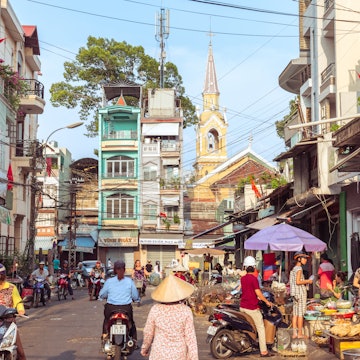
Life on the tracks: my 2 years living on Hanoi Train Street

Mar 27, 2020 • 7 min read

Fabienne Fong Yan worked in the first coffee shop to ever open on Hanoi Train Street, and saw what life was like along the tracks before Instagram changed everything.
It was just a narrow street with one oddity: train tracks running through the middle. Neglected for decades, it was suddenly brought into light by one café who tempted travelers to the spot. Two years later, it was one of the most famous places in Vietnam. But by October 2019, the touristic hype was all over, as local authorities shut down the street.

Before the hype: a neglected hidden gem
Like most people in 2017, I first discovered the train street by accident. There was no café or plastic stools along the railway back then, only a very quiet atmosphere and some elders chit-chatting on their doorstep on the train tracks. There used to be a quaint quietness on that street, although it was directly crossing two big avenues - Dien Bien Phu and Tran Phu streets, only minutes from the bustling Old Quarter.
Nobody in Hanoi really paid attention to the train street and it saw only a few lost travelers. The families there were rather poor and neglected. Who would want to live in a house with a train literally passing on your threshold several times a day? It was loud, inconvenient, dangerous. Definitely undesirable. It used to be one of the most ill-frequented areas in the city center: dark, dirty, miserable. It had none of that glamour shown on Instagram later on.

Yet, at the end of 2017, one young Vietnamese woman got the idea - rather odd at the time, to say the least - to open a coffee shop along the tracks. She hadn’t grown up on the Train Street. Maybe that’s why she saw potential where locals only saw the ordinary.
How do you live with a train on your doorstep?
When I first met Thao Quach, the train street was not well known. Nevertheless, she opened The Railway Hanoi, the first coffee shop along the tracks. Thao and I became friends as soon as we met. I started by giving a hand for service, and soon our friendship hatched a partnership. That’s how for nearly 2 years, the Train Street became my adoptive home.

I was there almost every day, serving drinks to the occasional customer or taking curious travelers on street food tours. But at the beginning, locals looked at me very suspiciously. Not only because I was a foreigner, but also because I was taking part in a project not everyone approved of. For over a century since the tracks had been built by the French and the houses filled by railway workers’ families, the street has been left alone. Most houses were tiny - including ours - sheltering two or three generations in a room at the same time.
Conditions were far from easy. For a long first year, we didn’t even have water from 9am to 4pm. But life was always fascinating on the train street: watching elders having their tra da (green tea) on the tracks, mothers bathing their kids, men playing chess, grandmas putting the common stove in the middle of the railway to be shared before dinner… the track was our courtyard.
A lesson of persistence and community love
For the first months, Thao fought every day to convince the neighbours that change might be disruptive but not necessarily a bad thing. She created The Railway Hanoi project, aiming to connect foreign volunteer teachers with local kids who needed to learn English. “I want to bridge the gap between the inhabitants of the Train Street and the travelers,” she said.
“I want travelers to understand the soul of Hanoi Train Street: when people come to see us, they don’t know our neighbours. They don’t know one of the ladies’ family has lived here for three generations and both her children work for the railway department. Travelers take pictures of An - our baby neighbour - without even knowing that she’s a girl!”

The children of the Train Street were the first seduced by our café: they embraced newness, but also new faces, stories and friendships. Our favourite gypsy jazz playlist resonated on the street at the end of the afternoon while we waited for the train with our guests. We were as excited as they could be, even after seeing our 100th train. “Train’s coming!” 7-year old Ngoan would shout.
The young sisters Ngoan and An soon became our favourite little neighbours. They slowly got acquainted with us, timidly peering inside the café at the beginning, then demanding to come inside and draw on walls - Thao had given them coloured chalks to doodle around. They brought joy, they brought life. And one evening, their grandma invited us both for dinner. In Vietnamese culture, that is a very strong sign of acceptance into the community. Better, into the family.
The rise and fall of Hanoi Train Street
There is a Golden Age to everything. Hanoi Train Street is a perfect example of what mass tourism in the age of social media can do to a local community. At the beginning of 2019, travelers from all over the world were coming to see the train go through its exceedingly narrow street. As the distant “Choo Choooo” filled the air, everybody would get ready to take the best selfie of their lives.

From hidden gem to Instagram sensation, Hanoi Train Street made it to the top 10 must-see in Hanoi in less than 8 months. Over the course of 2019, over 20,000 images had been hashtagged #hanoitrainstreet or #trainstreethanoi on Instagram. The consequence? A skyrocketing value of the street and hyper-development of businesses, as is commonly seen in Vietnam.
In May 2019, I left for a 3-week holiday. When I came back, 5 new cafés were opened on our section and An and Ngoan had moved houses with their grandma; their landlord wanted to destroy their house and make a new coffee shop, right next to us. The family in the house across our tiny café had already left. Bye bye, railway kids. The cards were reshuffled: the Train Street belonged to business owners and tourists from then on.
In October 2019 however, local authorities suddenly ordered it to be shut down: a few trains had to be rerouted because too many tourists were standing on the tracks. The narrow street had reached its maximum capacity. It is true it had gotten out of control, nobody was listening to safety rules anymore and we were not equipped to manage the massive influx of tourists. So it was meant to happen. Curtain.
What's the future for Hanoi Train Street?
Hanoi Train Street used to be something very different and it’s irreplaceable, not only for travellers but my own life as well. Is the community going to be forgotten again? For weeks, policemen and barriers have blocked the access to the street: “We feel like caged birds,” one lady confided, “The train still comes but everything has changed-”
“CHOO CHOO!!”

There comes our train, drowning out her voice. We watch it brush the walls in a loud clanking and cranking, and somebody whispers its name: “Doi Moi”. Its meaning? “Changing Times”.
As of early 2020, no-one can tell what the future of the street may hold: amidst uneven negotiations, Hanoi Train street could remain shut, with businesses having to lay low for an undetermined time. It could even be destroyed, as per the original government plan, if not a touristic asset anymore. But Vietnam is the home of unexpected destinies. For now, nothing seems more important than listening to what local families want. They are the soul of the street and deserve to be heard. Can a responsible way to manage Hanoi Train Street be worked out? Only changing times will tell.
You might also like:
So your town got famous on Instagram. Here's what will happen next...
Hanoi's most essential street food
A guide to Vietnamese coffee















